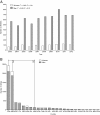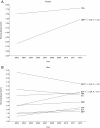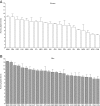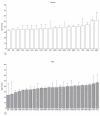Participation and performance trends in multistage ultramarathons-the 'Marathon des Sables' 2003-2012
- PMID: 23849138
- PMCID: PMC3710135
- DOI: 10.1186/2046-7648-1-13
Participation and performance trends in multistage ultramarathons-the 'Marathon des Sables' 2003-2012
Abstract
Background: The purpose of this study was to investigate participation and performance changes in the multistage ultramarathon 'Marathon des Sables' from 2003 to 2012.
Methods: Participation and performance trends in the four- or six-stage running event covering approximately 250 km were analyzed with special emphasis on the nationality and age of the athletes. The relations between gender, age, and nationality of finishers and performance were investigated using regression analyses and analysis of variance.
Results: Between 2003 and 2012, a number of 7,275 athletes with 938 women (12.9%) and 6,337 men (87.1%) finished the Marathon des Sables. The finisher rate in both women (r2 = 0.62) and men (r2 = 0.60) increased across years (p < 0.01). Men were significantly (p < 0.01) faster than women for overall finishers (5.9 ± 1.6 km·h-1 versus 5.1 ± 1.3 km·h-1) and for the top three finishers (12.2 ± 0.4 km·h-1 versus 8.3 ± 0.6 km·h-1). The gender difference in running speed of the top three athletes decreased (r2 = 0.72; p < 0.01) from 39.5% in 2003 to 24.1% in 2012 with a mean gender difference of 31.7 ± 2.0%. In men, Moroccans won nine of ten competitions, and one edition was won by a Jordanian athlete. In women, eight races were won by Europeans (France five, Luxembourg two, and Spain one, respectively), and two events were won by Moroccan runners.
Conclusions: The finisher rate in the Marathon des Sables increased this last decade. Men were significantly faster than women with a higher gender difference in performance compared to previous reports. Social or cultural inhibitions may determine the outcome in this event. Future studies need to investigate participation trends regarding nationalities and socioeconomic background, as well as the motivation to compete in ultramarathons.
Figures







References
LinkOut - more resources
Full Text Sources

